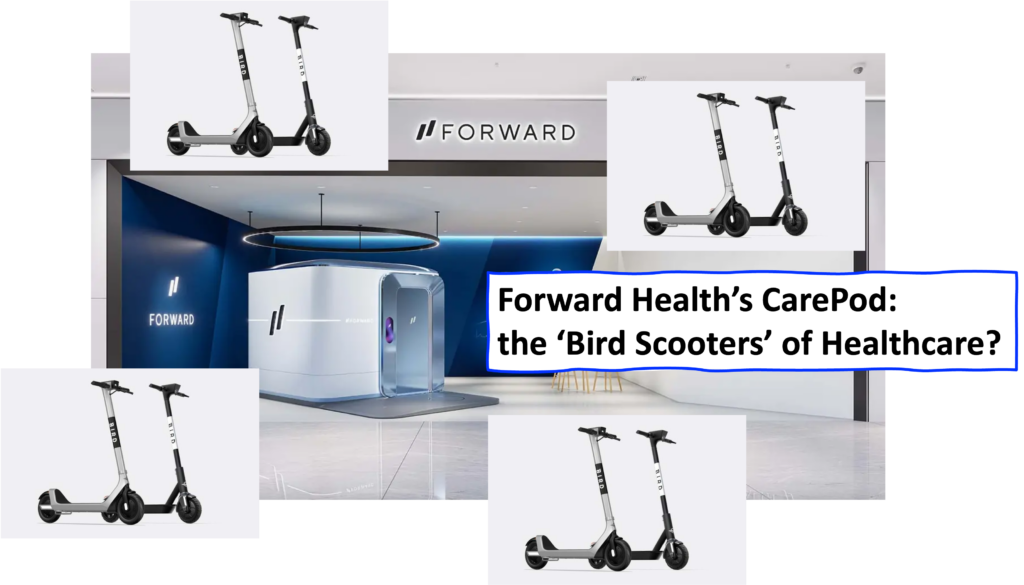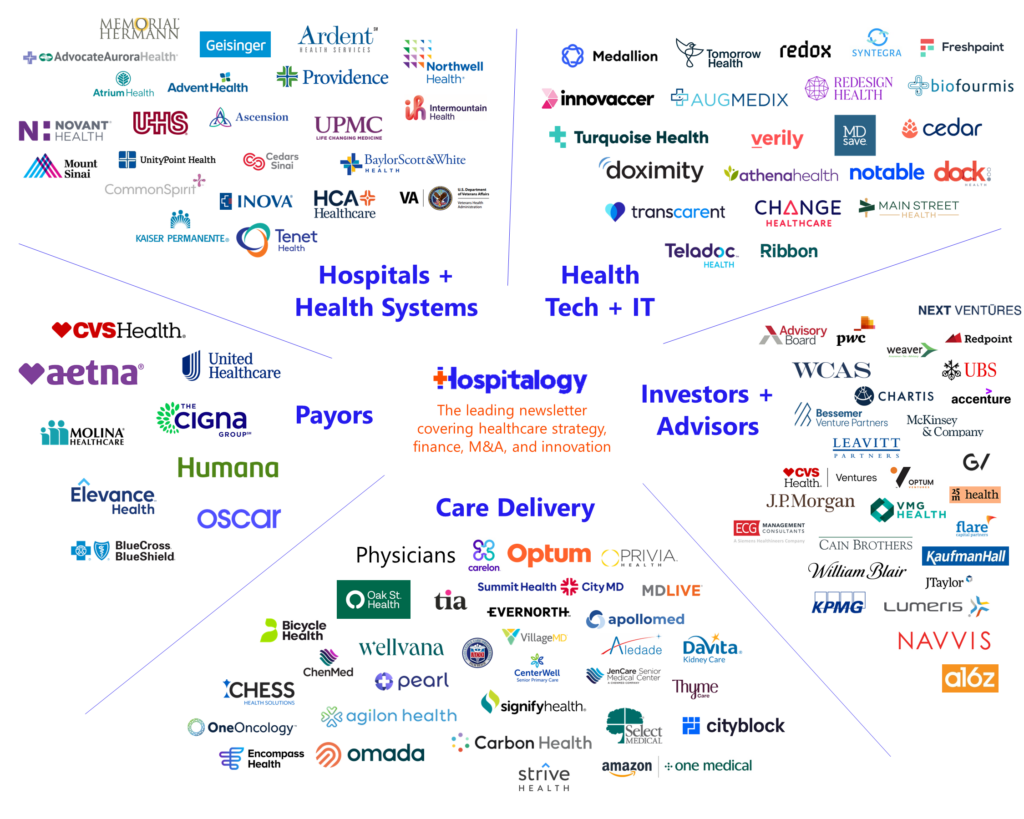Happy Tuesday!
What are you thankful for? Here’s what I’m thankful for: no Hospitalogy this Thursday. Sometimes even we degenerates need to get away.
Try not to bring up healthcare during the day’s festivities. I know it’s difficult for us Hospitalogists to resist debating the merits of value-based care, or whether Forward Health can build 3,200 CarePods in a year (more on that in a sec).
Today’s send is a quick one (~1,000 words) with some thoughts on Forward Health’s CarePods pivot. I’d love to hear your perspective on it, so feel free to shoot me a reply with your thoughts.
Finally, we’ll resume normal Tuesday news sends in December as I’ll be highlighting some nonprofits next week for Giving Tuesday.
Forward Health’s CarePod: the ‘Bird Scooters’ of Healthcare?

Longstanding health tech unicorn Forward Health took social media by storm this past week by announcing its pivot into an AI-enabled, standalone medical station called a…CarePod.
From the company announcement (including this slick video), CarePod is Forward’s first step in its new master plan to introduce a bold future for patient care. Forward is hyper-focused on the healthcare consumer and wants these CarePods to empower its subscribers with a tech-forward product offering. From the blog, subscribers will have access to numerous health datapoints and personalized plans tailored to themselves over time:

- Health Apps help you address a wide range of disease areas, including diabetes, hypertension, and depression & anxiety. Forward plans to increase coverage of Health Apps over time, such as Prenatal Care, Advanced Cancer Screening, and Polygenic Risk Analysis. Data from your CarePod visit is seamlessly and securely transmitted to Forward’s platform, enabling continuous progress monitoring, identifying disease risks, and providing in-depth evaluations using sensors, laboratory tests, and vital sign measurements. You can access all your health data 24/7 in the Forward mobile app…Health data and personalized plans are continuously updated and made available in the Forward mobile app.”
The CarePod is a marked pivot from Forward’s previous business model it launched back in 2017 – AKA, creating an Apple-like clinic experience in a direct primary care subscription-based offering. That business still exists as well and holds a 19-clinic national footprint in most major cities.

But that offering must not have moved the needle from an investment standpoint. So now we have healthcare’s shiniest new Silicon Valley toy on the block – a CarePod!
Still, despite the pivot, the CarePod concept builds on several of the initiatives that Forward deployed in its clinic business, namely its full-body scanner for baseline vitals, deep integration of tech and touch screens, and of course, the mobile app with clean UI and readily available clinicians for messaging.
One Step Forward…
I have a lot of thoughts about the CarePod which I’ve grouped into two main schools of thought:
Techno-Optimist Mode: The tech is freakin cool, and I’m an optimist at heart. Concepts like these feel like magic to me and push the innovation needle forward in healthcare. I can appreciate Forward seeing the software assets and in-clinic workflows it developed and thinking of other outside of the box (er…inside the box?) use cases for those features. Being able to access a bunch of healthcare data and testing over time under your own power in a direct fashion is a refreshing consumer-forward approach to healthcare, and I would definitely try it if it comes to Dallas. Thinking about solving big problems like the lack of scalability for the doctor or clinician office is something I can get behind and commend the effort. And if Forward is thoughtful about launching these CarePods alongside its core market segments (20-30 year olds, worried well, gym-goers, Bryan Johnson focused longevity folks) say, in gyms – I could see Forward gain serious traction, and I understand the moonshot investment case.
Full-on Bear Mode: It’s hard NOT to poke holes in the business today, especially when Forward is trying to develop 3,200 of these in a year (assuming the TechCrunch article is accurate). For that reason, the concept from a business perspective has me scratching my head. A recent write-up from HIStalk explains why better than I ever could (in a much more dismissive tone), and I can’t help but agree with many of the points, the most compelling of which I’m expanding on below:
- Similar doc in a box business models have failed plenty of times before – is CarePod revolutionary / innovative (e.g., its ‘custom-built LLM,’ body scanners, UI, experience, etc.) enough to succeed? Is the time right for this?
- No in-person clinician access at all for an initial in-person service seems pretty odd, especially when Forward has a physical clinic presence. Maybe Forward could think about some health system or in-market primary care partnerships down the line.
- A subscriber / patient is relying on quality control from best-case, a medical assistant (who probably could be making more money delivering Amazon packages) to keep the Pod sanitary, administer blood tests, etc. and Forward as a company is trying to provide oversight for at least 3,200 of these by the end of 2024. This is yet another healthcare service that relies on entry level labor (ABA, home health). Not to mention potential regulatory risk. This dynamic in particular makes me pretty skeptical.
- Forward as a company now has to identify, plan, pay for, and develop 3,200 CarePod sites across the nation. I’m terrible at logistics, but this sounds like an absolute logistical nightmare to me.
- It doesn’t seem as if there’s any downstream value capture present in a typical primary care playbook e.g., pharmacy, specialty care, testing, diagnostics, etc. All you have is a subscription service. Maybe you could start an online marketplace for supplements and at-home equipment, or partner with gyms, food services, etc.
- This eviscerating quote from HIStalk is spicy: “From a societal health perspective, convincing people that running app tests in a mall is equal or better to seeing an actual clinician is not a positive accomplishment, nor is a system that cares so little about consumerism and preventive health that people flee to the healthcare equivalent of a photo booth in front of a defunct Sears.”
- I don’t think Forward wants to replace the doctor, and from what I understand, they recommend still having regular insurance (of course) alongside the subscription, but this point is well received.
I can’t help but think that this is the more likely scenario that played out for Forward: a bunch of high profile investors dumped a ton of money into a longevity-focused direct primary care business with a sleek UI, some bells and whistles, and inflated the company’s valuation to $1B+ during ZIRP times.
Then when they realized employing clinicians in a commoditized, low-margin segment of healthcare (primary care) wasn’t going to move the venture needle, Forward decided to pivot to an ‘AI-enabled’ tech concept to save face, somehow getting investors to shovel another $100M into the furnace. So now Forward & Co. are stuck having to try and build thousands (three thousand two hundred to be exact) of pods by the end of 2024 and get some commercial traction. It’s not impossible, but…that seems tough.
Verdict: Forward is the ‘Bird Scooters’ of Healthcare – for now
This is not the Tesla of healthcare quite yet. I’m more inclined to believe that this is going to turn into the Bird – of healthcare – e.g., a really good idea, works in certain markets like Austin, TX, but ultimately a bad business with serious logistical challenges.
Join the thousands of healthcare professionals who read Hospitalogy
Subscribe to get expert analysis on healthcare M&A, strategy, finance, and markets.
No spam. Unsubscribe any time.
If you enjoyed this post, subscribe to Hospitalogy, my newsletter breaking down the finance, strategy, innovation, and M&A of healthcare. Join 20,500+ healthcare executives and professionals from leading organizations who read Hospitalogy! (Subscribe Here)

